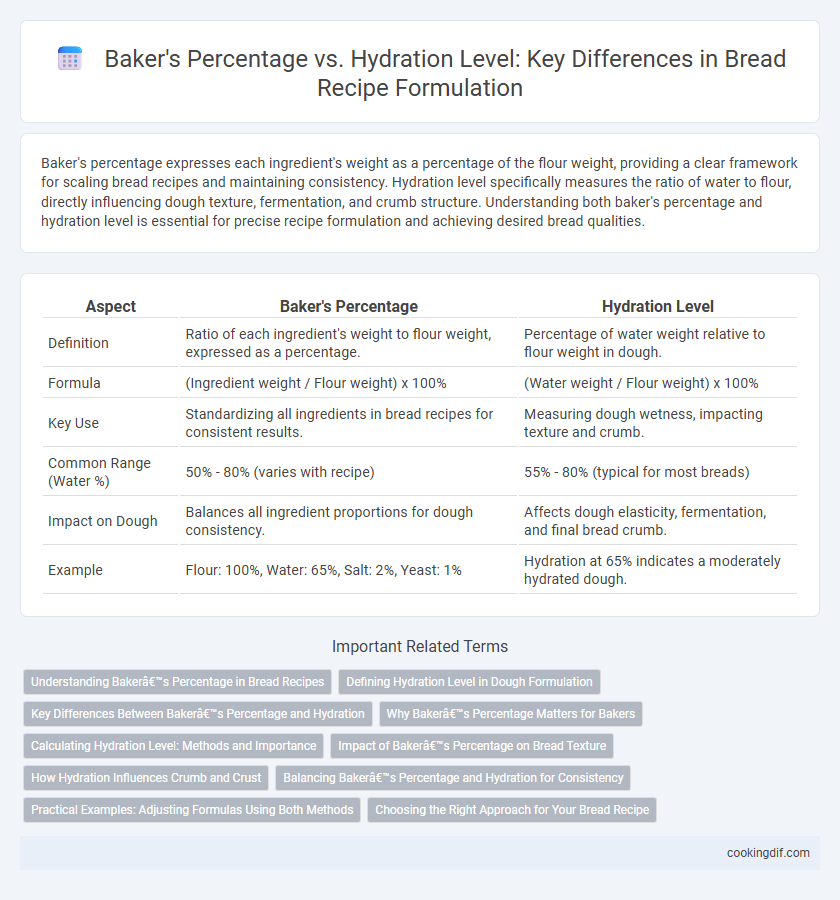Baker's percentage expresses each ingredient's weight as a percentage of the flour weight, providing a clear framework for scaling bread recipes and maintaining consistency. Hydration level specifically measures the ratio of water to flour, directly influencing dough texture, fermentation, and crumb structure. Understanding both baker's percentage and hydration level is essential for precise recipe formulation and achieving desired bread qualities.
Table of Comparison
| Aspect | Baker's Percentage | Hydration Level |
|---|---|---|
| Definition | Ratio of each ingredient's weight to flour weight, expressed as a percentage. | Percentage of water weight relative to flour weight in dough. |
| Formula | (Ingredient weight / Flour weight) x 100% | (Water weight / Flour weight) x 100% |
| Key Use | Standardizing all ingredients in bread recipes for consistent results. | Measuring dough wetness, impacting texture and crumb. |
| Common Range (Water %) | 50% - 80% (varies with recipe) | 55% - 80% (typical for most breads) |
| Impact on Dough | Balances all ingredient proportions for dough consistency. | Affects dough elasticity, fermentation, and final bread crumb. |
| Example | Flour: 100%, Water: 65%, Salt: 2%, Yeast: 1% | Hydration at 65% indicates a moderately hydrated dough. |
Understanding Baker’s Percentage in Bread Recipes
Baker's percentage is a method used in bread recipes to express ingredient quantities as a percentage of the flour weight, enabling precise recipe scaling and consistent dough formulation. Hydration level, a key factor within baker's percentage, refers to the ratio of water to flour, directly impacting dough texture, crumb structure, and crust quality. Understanding baker's percentage allows bakers to adjust hydration and other ingredient ratios systematically to achieve desired bread characteristics and optimize fermentation.
Defining Hydration Level in Dough Formulation
Hydration level in dough formulation refers to the ratio of water weight to flour weight, expressed as a percentage, which directly impacts dough consistency and bread crumb texture. Unlike baker's percentage that accounts for all ingredients relative to flour weight, hydration percentage specifically measures water content, playing a critical role in yeast activity and gluten development. Optimal hydration levels vary by bread type, typically ranging from 60% in lean doughs to over 80% in high-hydration artisanal breads, influencing dough extensibility and final product quality.
Key Differences Between Baker’s Percentage and Hydration
Baker's percentage expresses each ingredient as a percentage of the total flour weight, allowing precise scaling and consistent dough formulation. Hydration level specifically refers to the ratio of water to flour in the dough, directly impacting dough texture and crumb structure. Understanding the distinction helps bakers control dough behavior and optimize bread quality by balancing ingredient proportions and moisture content.
Why Baker’s Percentage Matters for Bakers
Baker's Percentage provides a standardized method to express ingredient ratios relative to flour weight, crucial for consistent bread recipe formulation. This system allows bakers to easily scale recipes up or down while maintaining precise hydration levels, directly impacting dough texture and fermentation. Understanding Baker's Percentage ensures control over crumb structure and dough elasticity, leading to predictable baking outcomes and bread quality.
Calculating Hydration Level: Methods and Importance
Calculating hydration level in bread recipes involves dividing the weight of water by the weight of flour, expressed as a percentage, crucial for dough consistency and crumb texture. Baker's percentage standardizes ingredient ratios, with hydration level as a key variable influencing dough elasticity and fermentation. Precise hydration calculation ensures recipe accuracy, optimal gluten development, and desired bread quality.
Impact of Baker’s Percentage on Bread Texture
Baker's Percentage directly influences bread texture by precisely controlling ingredient ratios relative to flour weight, enabling consistent dough characteristics. Higher baker's percentages for water result in increased hydration, producing a softer crumb and open crumb structure favored in artisan breads. Adjusting flour and water percentages within baker's percentages allows bakers to achieve desired crust crispness and crumb elasticity, optimizing final bread quality.
How Hydration Influences Crumb and Crust
Hydration level, expressed as a baker's percentage, critically impacts bread crumb texture and crust development by controlling dough consistency and water retention during baking. Higher hydration percentages, typically above 70%, yield open, airy crumb structures with thinner, crispier crusts, while lower hydration results in denser crumbs and thicker, chewier crusts. Optimal hydration balances gluten development and starch gelatinization, enhancing both chew quality and crust coloration in artisanal bread recipes.
Balancing Baker’s Percentage and Hydration for Consistency
Balancing baker's percentage and hydration level is essential for consistent bread dough formulation, as baker's percentage expresses each ingredient's weight relative to flour, while hydration level specifically measures water content. Optimal hydration varies with flour type but typically ranges from 60% to 75%, influencing dough texture, crumb structure, and fermentation activity. Precise adjustment of hydration in baker's percentages ensures repeatable dough consistency, improving bread volume and crumb quality across batches.
Practical Examples: Adjusting Formulas Using Both Methods
Baker's percentage expresses each ingredient relative to the flour weight, allowing precise scaling of dough components, such as adjusting water from 65% to 70% hydration to modify dough firmness. Hydration level specifically measures the ratio of water to flour, directly influencing crumb texture and crust development in bread recipes. Practical adjustments involve increasing yeast proportionally to hydration changes to maintain fermentation balance, exemplifying how combining baker's percentage with hydration level fine-tunes bread consistency and rise.
Choosing the Right Approach for Your Bread Recipe
Baker's percentage expresses ingredient ratios relative to flour weight, enabling precise control over dough consistency and ingredient balance. Hydration level specifically measures the water-to-flour ratio, directly impacting dough texture and crumb structure. Selecting the right approach depends on recipe complexity and desired bread characteristics, with baker's percentage offering comprehensive formulation and hydration level focusing on moisture content.
Baker’s Percentage vs Hydration Level for recipe formulation Infographic

 cookingdif.com
cookingdif.com